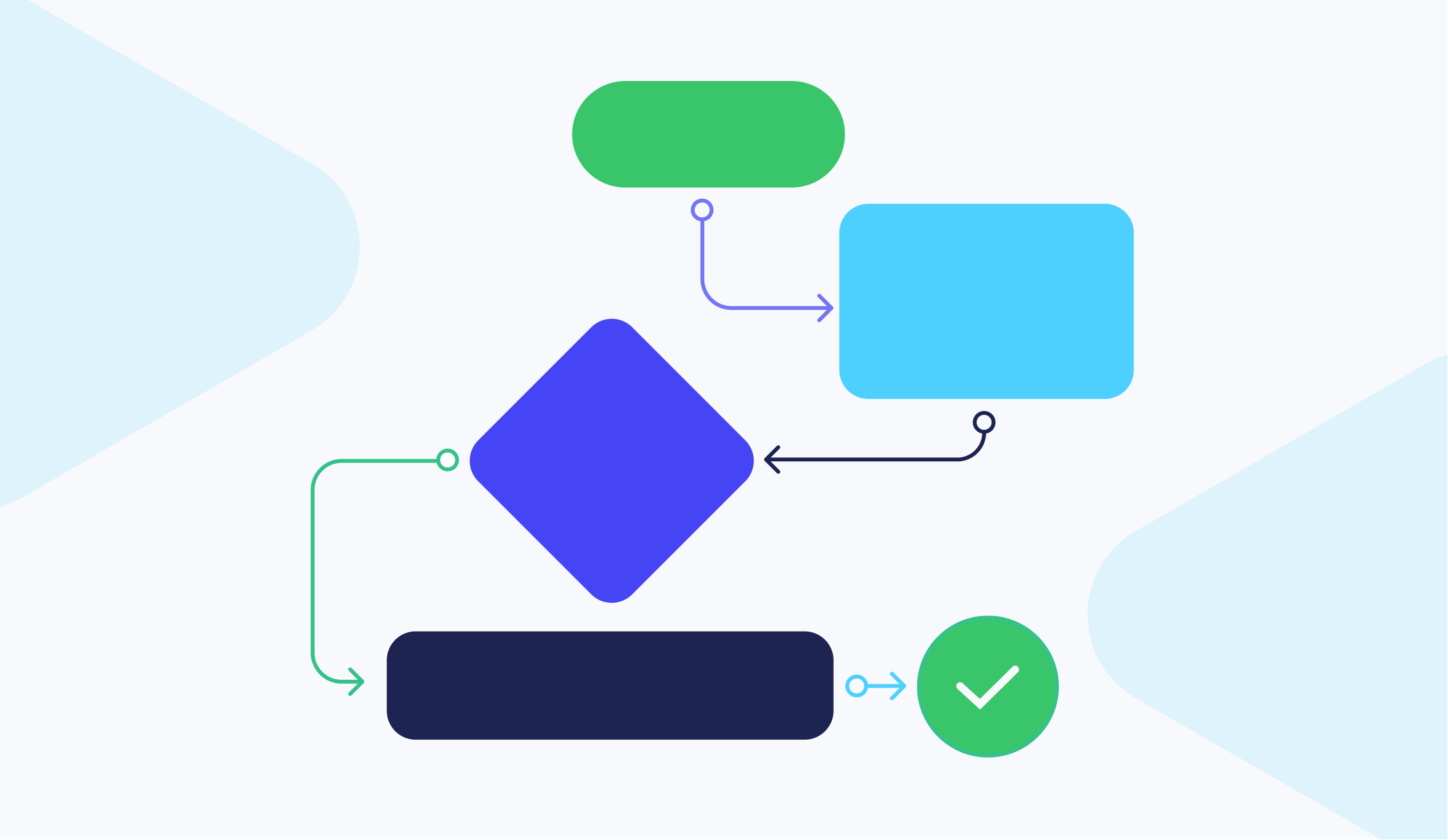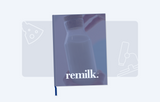
15 min read
Procurement Analysis: a Game Changer for Purchasing Strategically
About every second Chief procurement officer – 49% of CPOs, according to Deloitte – invests in developing digital analytics skills. Read about why analytics is so important and how it can benefit your business.
With the global market expansion and deepening supply chain complexity, the roles of procurement leaders have evolved from tactical to strategic.
Nowadays, procurement departments not only focus on the day-to-day buying operations but also search for the most efficient ways to go about them. To navigate complex and fast-paced markets, an agenda of spend analysis is introduced as a part of the procurement function.
Procurement is broadening to include extensive work with spend data. While strategizing, keeping feet on the ground is important, and that's when data comes in especially handy.
Keep reading to learn more about procurement analytics principles and how they can benefit your business:
- What is procurement analysis
- Types of procurement analysis
- Procurement analysis steps
- How procurement analytics benefit businesses
- Procurement analytics in practice
- Challenges of procurement analysis
- Software infrastructure for efficient procurement analysis
- Frequently asked questions
What is Procurement Analysis
Procurement analysis consists of collecting and reviewing historical data to evaluate past performance, on-the-go data mining to assess the current state and predict threats and opportunities for the future, and using all of this to make fact-based decisions.
Procurement analytics is a component of business intelligence and is increasingly important, especially in complex organizations. Consolidated data, subjected to analysis, reveals facts and coherences that might have stayed unnoticed otherwise.
Thorough analysis allows procurement professionals to surface, visualize, and present purchasing patterns, which are then evaluated by the stakeholders. Procurement analytics, built on unbiased data, is often perceived as a single source of truth.
It can answer the following questions for business:
- What are we buying?
- From whom are we buying?
- In what quantities are we buying?
- How much are we spending?
- How often do purchases happen?
- How do we categorize purchases? Which category represents the largest spend?
- What are the average market prices, and what are we paying?
- Are our payment and delivery terms fair?
- Are our business needs met?
- Is it possible to reduce costs? By how much?
- How efficient are our internal workflows, RFP, and P2P cycles?
For high-quality analytics, companies implement procurement software solutions and hire data scientists to extract, structure, and process data in the shortest possible time with the highest accuracy.
Procurement analysis requires a deep understanding of the industry and particularities of the supply chain, as well as strong analytical skills and modeling capabilities.
Types of Procurement Analytics
There are numerous ways to use procurement data, and the type of conducted analysis depends on what you are looking to achieve: describe, diagnose, predict or prescribe.
- Descriptive analytics focuses on describing past events and finding patterns.
- Diagnostic analytics seeks to understand causal relationships and explain why something happened the way it did.
- Predictive analytics identifies trends in spending and procurement organization.
- Prescriptive analytics offers actionable insights and possible future procurement performance scenarios. It helps define specific steps to achieve purchasing goals and mitigate risks and disruptions.
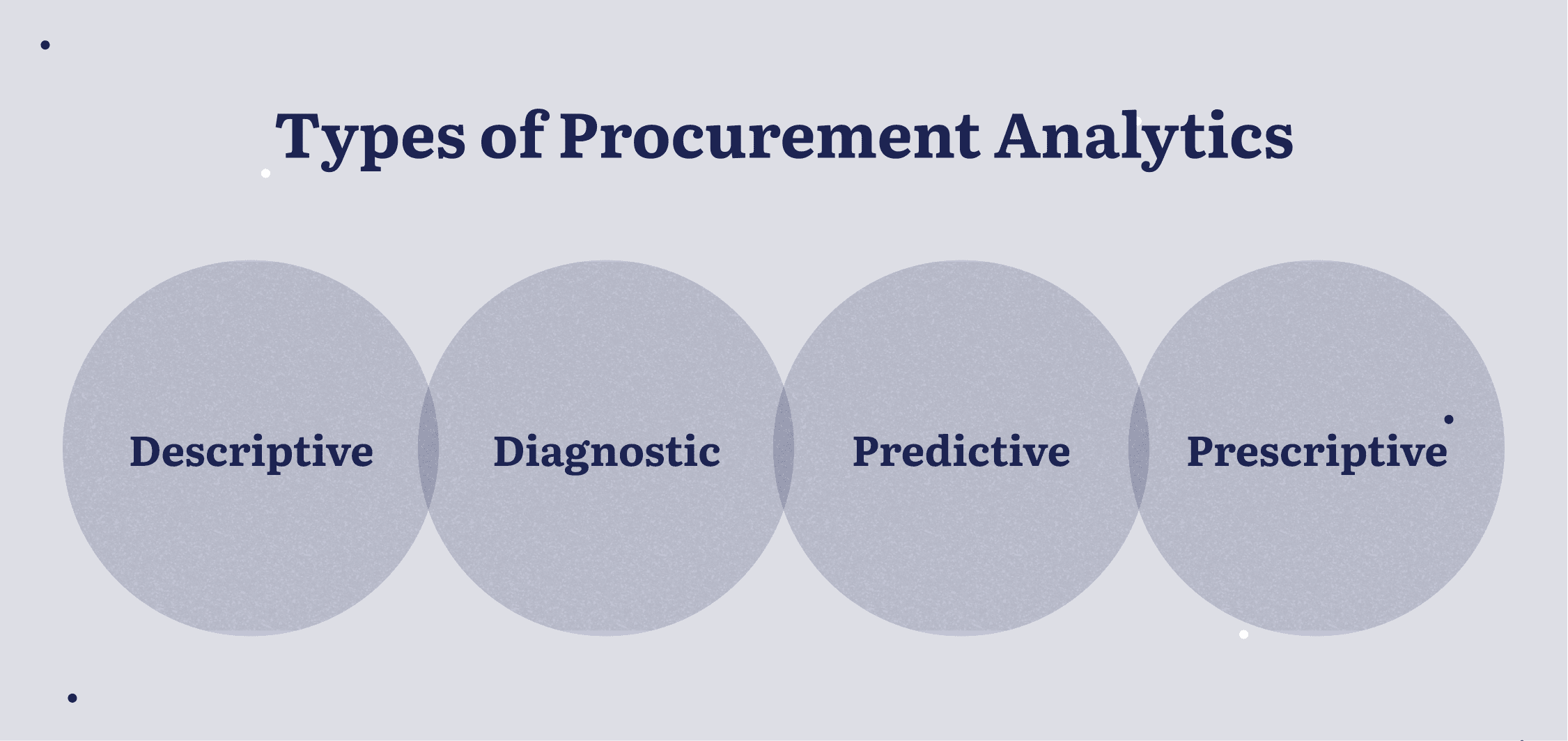
Procurement Analysis Steps
The saying goes that data is everything nowadays. Data exists in spreadsheets, software solutions, e-mails – the list goes on. It’s always there, but making sense of it is a different story.
The key is to determine which information is important and find a way to extract it from large data pools. That requires practical market knowledge, the right tools, and familiarity with procedures.
Let's look at the specific steps to navigate procurement analysis.
Step 1 – Extract Data
The first step of the analysis process is to extract the necessary data from all possible sources and consolidate it in one central database. Not all data is relevant for all businesses, so defining what would be useful is important.
Start with putting together a list of sources – internal and external.
Internal data sources are corporate applications and other documentation, such as:
- procurement management software, ERP or other solution (for example, warehouse or inventory management software);
- accounting system;
- e-mails;
- documents, paper or electronic, Excel spreadsheets, etc.
External data sources are found outside of the company's systems and databases, such as:
- suppliers;
- market reports;
- bank information;
- public financial statements;
- external analytics databases, etc.
Data extraction, even from well-known and easily accessed internal sources, is a complex task that requires time, effort, and often financial investments.
Depending on the nature and size of the business, some companies might need to hire dedicated professionals. For instance, this might be:
- A data scientist to implement correct workflows and choose the right sources, and
- A data engineer to build and automate integrations between the systems involved.
In the beginning, extracted data might be messy and hard to understand, but it's a question for the following step.
Step 2 – Consolidate
Once extracted, data has to be stored somewhere.
Depending on the nature, volume, and initial format of data, it can be stored in various ways – on a dedicated server, in the data warehouse, and, in theory, even in a printed format (but that, of course, is not the most efficient option).
An outsourced customizable cloud server is likely the most popular solution nowadays. With one, data is safely stored and easily accessed. A cloud server can also be a part of analytics software.
Step 3 – Clean, categorize and enrich
Data has to be processed for further use. Check its quality first to determine whether it has to be cleaned and formatted. For example, it might be necessary to standardize the currencies to extract analytical value from the invoices.
Categorization brings data to a single taxonomy, and homogeneous information is then available for analysis.
Step 4 – Analyze
When cleaned and classified, data can be analyzed. This analysis involves examining a piece of detailed transparent data and applying proper statistical methods to get a concise but specific number.
Procurement professionals should determine a clear analysis goal and ask relevant questions to see how multiple factors can be connected. Based on the type of analysis, a different question can be asked:
- "How was it going?" for the descriptive analysis;
- "Why this happened?" for the diagnostic analysis;
- "How will it look?" for the predictive analysis; and
- "What should we do about it?" for the prescriptive analysis.
Step 5 – Visualize
In the end, a large data pool can be reduced to several diagrams and charts. Data visualization cannot be underestimated when it comes to sharing the outcomes of the analysis. Visuals should answer specific questions, be easy to interpret, and, if possible, interactive.
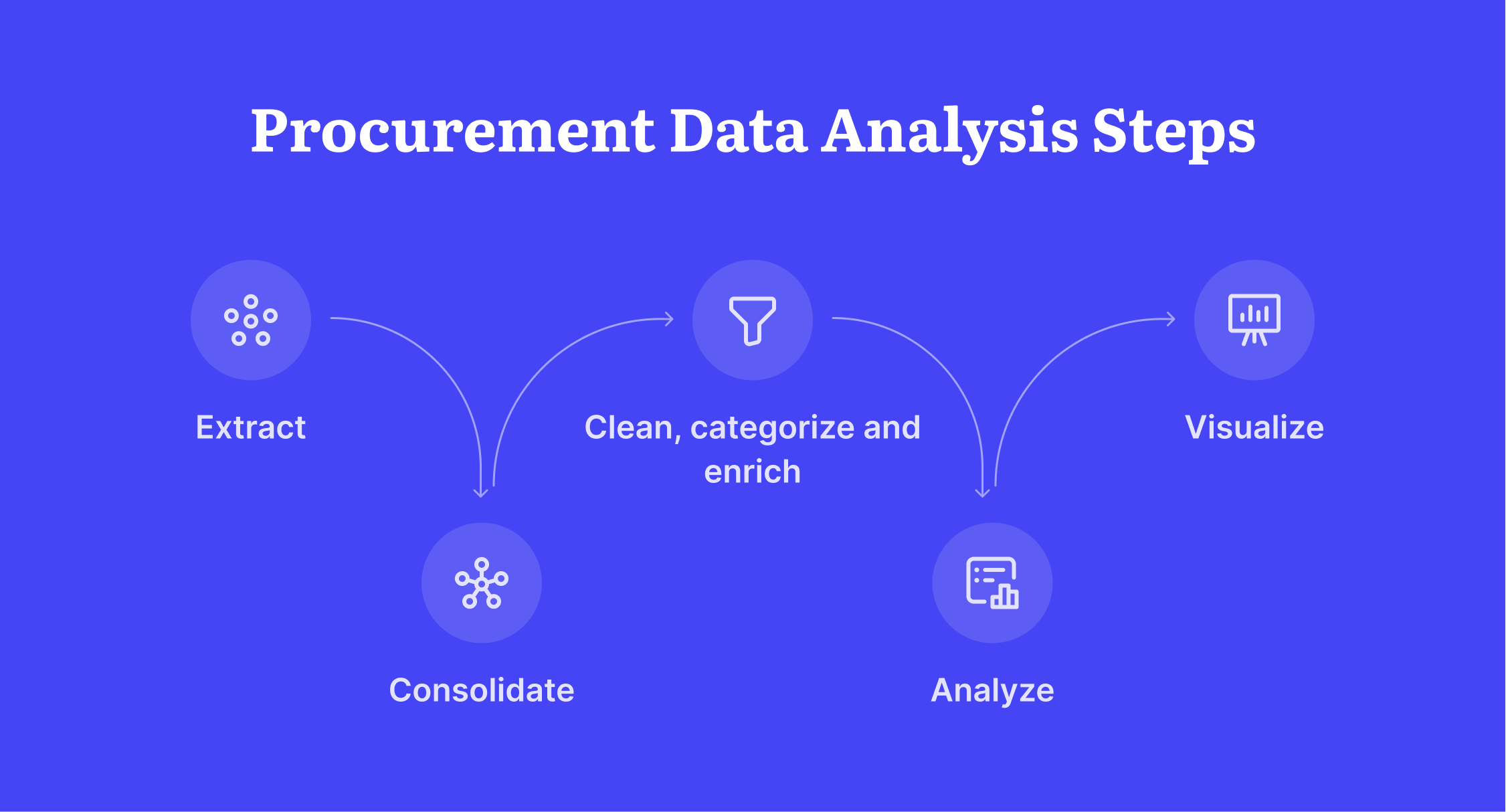
How Procurement Analytics Benefit Businesses
Advanced procurement analytics is useful in many instances. Various departments across companies can benefit from it – in market research, when developing marketing and manufacturing strategies, in human resources management, and many other areas.
Spend analytics is an especially important information source for specialists in the procurement and manufacturing departments, namely:
- Chief procurement officers;
- Procurement and purchasing managers;
- Category managers;
- Quality assurance specialists; and
- Manufacturing managers.
Analytics are key to gaining a complete overview of buyers' and suppliers' tendencies and aligning a company's spending with business goals. Insights from procurement analytics can help achieve KPIs and ensure on-time production outputs.
Procurement analytics are also extremely helpful during unstable times – for example, COVID-19 and war-related supply shortages. Companies rely on data to design actionable plans, diversify purchasing options, and secure supply chain stability.
Let's look at specific examples of where procurement analytics can come in handy.
Category Management
Procurement analytics help understand procurement complexity for each particular category of goods and services and build efficient category-oriented purchasing strategies.
Sourcing
Data helps you understand the market for strategic sourcing opportunities and potential partners and define the best time and place for running sourcing activities. Analytics also offers invaluable insight into the potential sources' quality and helps avoid failed deals.
Supplier Management
Managing supplier relationships is especially important for the business, as vendors and suppliers are the core of the supply chain.
Data is important while researching for new vendors and suppliers and comparing offers across the market:
- How many suppliers provide similar goods and services?
- Who offers the most suitable payment and delivery options?
- Is it better to assign the contract to the existing suppliers or select new ones?
Analytics is also invaluable for tracking the KPIs of contracted suppliers and evaluating supplier performance and reliability:
- How are suppliers performing?
- Can they guarantee the availability of requested goods and services?
- Do they change prices often?
- Are their payment options flexible enough?
- Can they guarantee timely delivery?
With a growing number of contracted suppliers, organizations face the need to segment them by different variables. Criteria for this may vary by supplier size, frequency of orders, the value of purchased items, etc.
This data is usually cross-referenced with the earlier point in time and used to design a future supplier management strategy.
Contract Management
Another way in which procurement analysis helps businesses is in contract management. Data is crucial for effective negotiation and getting favorable terms. For example, it's possible to request a better price or volume discount with a predicted amount of future purchases.
After closing a deal, poor contract management can result in significant financial losses. Procurement analytics help to ensure that contracted terms are followed and identify maverick spending. With data at hand, it's easy to track the renewal periods and ensure timely preparations.
Procurement Documents
Analysis of procurement documents, such as purchase requisitions, purchase orders, and invoices, provides an invaluable insight into the company's procedural efficiency.
By evaluating cycle times, organizations discover gaps in document management and missed automation opportunities. In addition to this, by comparing purchase requests with actual outgoing payments, businesses are able to tackle the problems with reconciliation and avoid wasteful spending.
Risk Management
Analytics also assists in identifying and mitigating procurement risks.
Data reveals weak spots in relationships with suppliers, possible price volatilities, supply chain disruptions, and processes prone to human error. This information gives organizations the space and time to prepare and develop strategies to deal with possible consequences.
Expense Monitoring
There are two types of spending to monitor: direct and indirect.
Direct spend refers to the purchase of goods and services necessary to produce the company's final product, such as raw materials. Indirect spend includes expenses needed to run the business but that are not involved in the production itself like marketing costs, office supplies, transportation, etc.
It’s important to track both. While direct spending is quite obvious, indirect is more difficult to monitor and is often underestimated. If not tracked, indirect spending can amount to more than expected and hurt the company’s budget. Analytics are invaluable for preventing that.
Cost Reduction
Analytics helps identify opportunities to save money. For example, this might be done by minimizing maverick spending or simplifying approval cycles to reduce operational costs.
Data can also provide an estimate about how altering existing processes could positively impact on the company's bottom line.
Demand Forecasting
Businesses introduce analytics to plan and prepare for the future procurement demand – what will have to be purchased based on the customers' needs.
When planning purchases with accurate forecasting in mind, organizations minimize the risk of supply shortages or overstocking, thus avoiding related spendings such as higher prices for last-minute purchases or excessive warehouse expenses.
Price Change Forecasting
To stay in the loop amidst constantly changing markets, businesses should be able to anticipate price changes and consider innovations and trends to mitigate the impact.
In volatile markets, prices might change several times daily, while others are more robust. Gathering real-life data and subjecting it to analysis results in a solid base for predicting market behavior and developing scenarios to deal with it.
Supporting The Company's Business Goals
Organizations aspire to align purchasing with general business goals, and analytics is crucial for creating a realistic plan stemming from real-life numbers. Data helps understand the market, identify new opportunities, and integrate them into the procurement strategy.
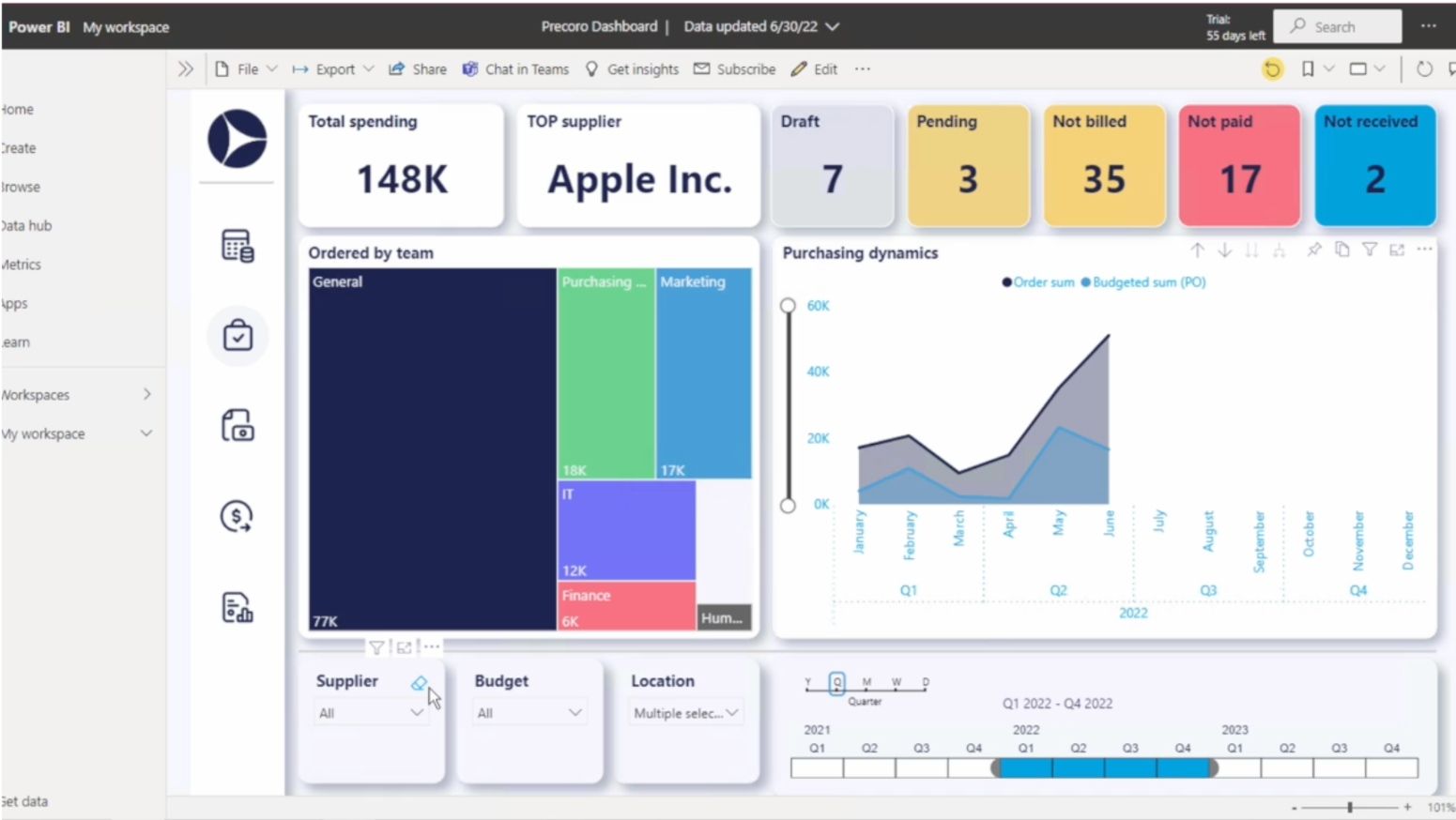
Procurement Analysis Cases
Let's look into several examples of how organizations can apply procurement analytics.
Streamline Procure-to-Pay Cycle
Procure-to-pay is a comprehensive concept covering a number of processes. Information on each step of the P2P cycle may be received from different departments or professionals and is often chaotic.
The analytical approach motivates procurement and finance professionals on all levels to integrate data across the departments to accurately evaluate the P2P cycle times.
By answering the following questions through data analysis, procurement specialists can find ways to drive the efficiency of the P2P cycle:
- How easy is it to find required goods or services from the catalogs of contracted suppliers?
- How long does it take to create, review, and approve a purchase requisition and purchase order?
- How promptly do vendors react upon receiving the purchase order?
- What is the rate of availability of requested goods and services?
- How long does delivery take?
- Do delivered goods and services meet the requirements of the initial orders?
- How long does the reconciliation process take? How long does it take to receive items, conduct 3-way matching, and pay the invoice?
Questions might differ based on the organization specifics, but the objective is universal – to discover operational bottlenecks that impair performance and optimize the P2P cycle.
Reduce Maverick Spending and Prevent Fraud
Procurement data ensures that purchases are made per the negotiated conditions. Contract utilization is one of the key indicators of whether the company is spending efficiently.
An organization might have good contracts with favorable terms negotiated but then have a significant amount of purchases made off-contract. There might be two reasons for that: either the contracts don't cover procurement needs fully, or it's done on purpose.
In any case, it's a clear signal to investigate the issue. Managers might consider renegotiating the contracts to include lacking items and, if needed, look into personnel activity.
Procurement analytics provide responsible specialists with detailed information on purchasing on- and off-contract; such information is split into categories, price ranges, departments, etc.
Looking at the contract utilization by item or supplier, procurement specialists can determine what needs to be done to avoid wasteful spending.
Reduce Sourcing Risks
Easily accessible analytics on the vendors' and suppliers' performance allows the procurement team to select the best one to cover specific needs.
While a large shoe manufacturing factory needs a supplier who guarantees availability of materials and fixed prices, an event-management company might search for a flexible vendor with last-minute offers.
Without evaluation data at hand, purchasing officers might end up purchasing from low-performing suppliers, therefore putting production at risk. By regularly tracking the performance of vendors and suppliers, the organization can assess the possibility of disruption and ensure everyone involved is aware.
Challenges of Procurement Analysis
Data used to be a byproduct of purchasing operations rather than an integral part of the procurement strategy. Therefore, it's not surprising that many organizations don't have the necessary infrastructure to gather and process data efficiently.
When the stakeholders and executives start implementing data analysis into daily procurement functions, they face several common challenges.
Unstructured Data
Especially at the start of the analysis implementation journey, existing data might be messy and require significant investments of time to make sense of it. For instance, when procurement operations are managed manually by several departments, formats are often inconsistent.
Organizations develop templates and specify workflows for data entry and extraction to overcome the issue. Employee training is also helpful. Finally, introducing regular data reviews gradually improves information readability.
Manual Operations
Managing procurement tasks manually results in data inconsistency and loss and no accountability for the errors.
For instance, with purchase orders tracked in shared spreadsheets, it's not always obvious who's responsible for the edits. Plus, requesting information from suppliers via e-mail might be time-consuming and leave too much space for human error.
With modern automation solutions, overcoming this challenge gets easier every day. Companies invest in technologies that digitize and automate procurement processes and can be integrated with other software to build smooth and robust ecosystems.
Data is then produced and safely stored in one system, ready for automated batch extraction.
Unaligned Team
It's not enough for procurement managers to understand the importance of analysis – they need executives' support and a team effort to actually implement it.
To prioritize procurement analytics, stakeholders should be willing to invest in the necessary infrastructure, and procurement officers and financial specialists should be willing to undergo the required training.
Working with data might not have an immediate effect, as accumulating a sufficient amount of relevant information takes time. It's important to motivate the team to stay goal-oriented and patient to see the tangible procurement analysis outcome.
Software Infrastructure for Efficient Procurement Analysis
Procurement analytics in Excel spreadsheets is still a thing nowadays; however, more and more organizations choose to turn to software solutions. It requires investment but pays off in a relatively short time span.
Spreadsheets offer some vital ways to structure and analyze numbers, but they are quite limiting in terms of the volumes of data they can process and the speed of processing.
Conducting procurement analysis manually is complicated, as it involves tracking numerous sources of information and calculating KPIs. Doing so regularly is an intense workload. The human factor is strong in a focus-demanding process like that, and errors are very likely to happen.
Spend analytics is about processing large amounts of data in short time spans. And software simply does that better, faster, and with fewer mistakes.
According to the Deloitte Global 2021 Chief Procurement Officer Survey, 76.1% of CPOs place digital transformation among their top priorities. It’s a 20% increase from 2019, and definitely a strong trend.
Let’s see how digitalization benefits analytics.
Automation
Procurement analytics solutions extract data from internal and external sources, accumulate it in one database, and present it in easy-to-read dashboards and schemes. Fact-based, informed decision-making is then only several clicks away.
Integrating procurement software with an analysis solution speeds up data processing and ensures quick and precise information exchange, making numerous reports available instantly.
Clean data
There are two aspects of cleaning the data with the aid of software.
It's easier to ensure that data is entered clean initially by limiting the data entry formats and defining the required fields in software settings.
However, even when internal data is well-structured, there are still external sources that might require additional cleaning. With automated data extraction, you can leave it to the software to clean the data and present it to the users in a refined way.
Security
In procurement analysis solutions, data is stored safely – mostly in the cloud with an emergency backup – and sent encrypted via integration channels. Companies that implement software face a much lower risk of data leak, loss, or compromise.
Customer support
With the help of software, organizations also get access to the support team's knowledge base and expertise in facing and fixing bugs, issues, and exceptions. Whether there's network instability, partial data extraction, or any other issue, procurement specialists have a support team to count on.
Choose Software Well
Selecting the right procurement and analysis solution is crucial for long-term efficiency. There are several criteria for procurement professionals and stakeholders to keep in mind.
Cost of acquiring, support, and development
Implementing software is an investment and a long-term commitment – once you move your operations into the system, you'll be using it for a while. Therefore, when selecting software, take into account the long-term sustainability of using it.
Answering the following questions can be a start:
- Are you going to finance a custom development or find an out-of-the-box solution with a subscription plan?
- Does the plan include a dedicated support manager, or is it case-based help?
- Will future software updates be required, and how are they paid for?
- Is the software customizable?
Functionality and user-friendliness
Software should be functional enough to meet the procurement analyst's needs and, at the same time, intuitive enough for new users. While selecting the system, stakeholders should consider the cost and time needed for staff onboarding and training.
Data quality and integrations
Software should guarantee data safety and offer secure integrations.
Data created and processed in the procurement software without API integrations stays isolated and will have to be transferred to the analysis software manually, taking us back to where it all started.
Let's look at how integrations are important, using Precoro and Power BI as an example. Power BI is a set of business intelligence tools widely used in numerous organizations across various markets. It allows for the creation of visual and interactive reports from virtually any imported data.
Precoro, as procurement software, is a workplace for daily requesting, purchasing, and invoicing operations. All these operations produce important procurement data. With a Custom Connector, Precoro users can safely and immediately export data into Power BI.
Using Precoro Custom Connector with Power BI, it's possible to:
- connect Power BI directly to Precoro data source via secure API;
- get the company's procurement data and use it for building reports and visualization;
- set up automatic updates to ensure data accuracy at any moment.
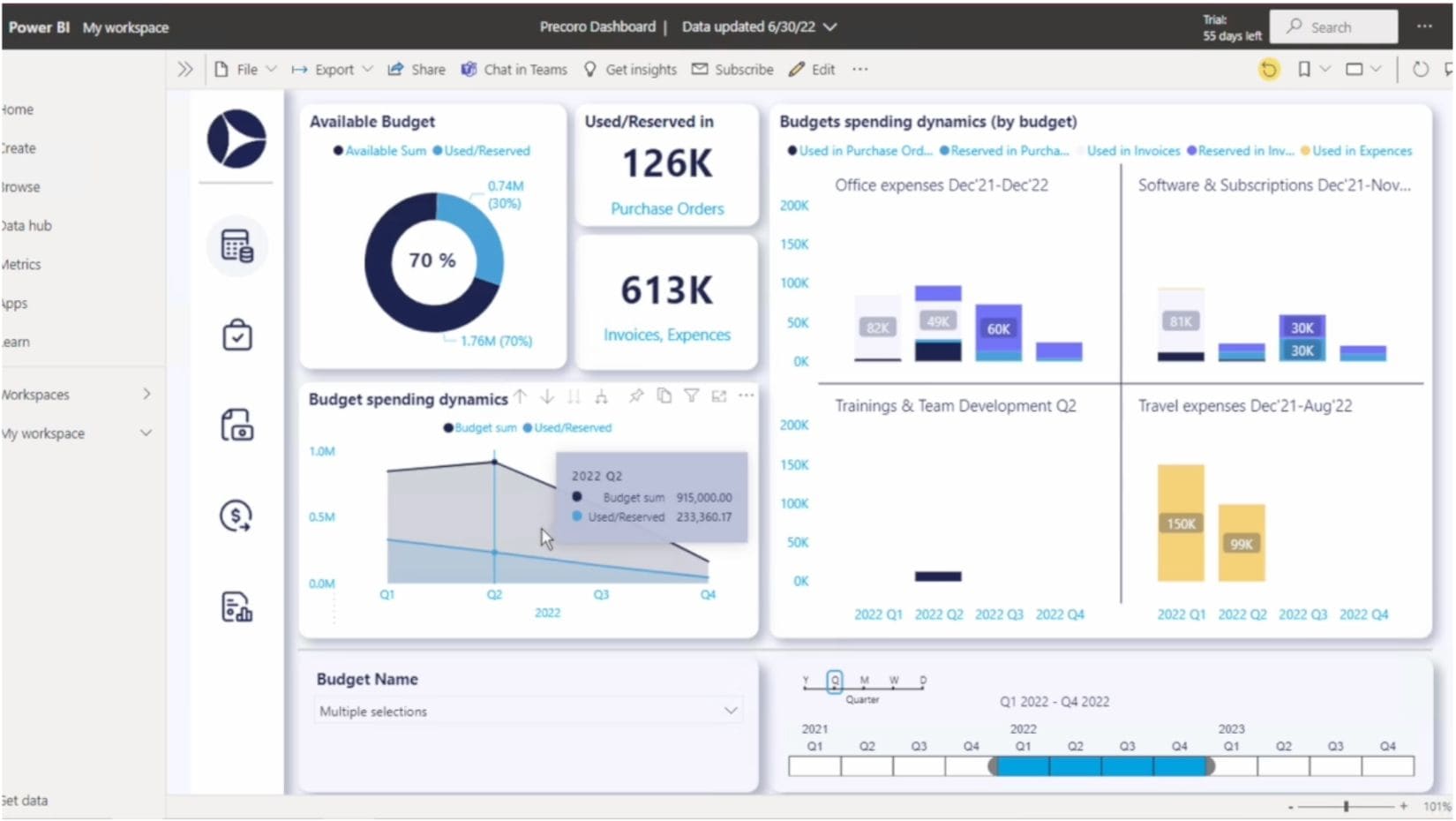
Via API connections, procurement and analytics automation solutions form a comprehensive ecosystem that efficiently tracks, understands, and predicts procurement practices.
Frequently Asked Questions
Data allows procurement professionals to gather, visualize, and present purchasing patterns to the stakeholders. Data compiled from procurement analytics is often perceived as a single source of truth.
Purchasing analysis, also known as procurement analysis, is an important component of business intelligence. Procurement analysis consists of collecting and reviewing historical data and of on-the-go data mining, all of which is used to make fact-based decisions. Such analysis allows procurement teams to evaluate past performance, assess the current processes, and predict future threats and opportunities.
There are four types of analysis that procurement professionals can conduct depending on what they are looking to achieve. These types are descriptive, diagnostic, predictive, and prescriptive.
There are a few specific steps that procurement teams take when it comes to purchasing analysis. They typically start by extracting data, then consolidating, cleaning, categorizing, and enriching it. The next steps are to analyze and visualize the data.
To Sum Up
The use of analytics helps evaluate past events and the current state of procurement organizations, predict future threats and opportunities, and forecast procurement performance. Data is extracted, collected, and analyzed to enable strategic decision-making.
Procurement data analytics is useful for various departments, including procurement, manufacturing, marketing, human resources, etc. Executives and stakeholders need analytics to align internal processes with business goals and ensure competitive advantage on the market.
Procurement analytics works with large amounts of continuously updated data, so professionals aspire to implement automated solutions. They streamline the process of extracting data from internal and external sources, collecting it in one database, and visualizing it.



